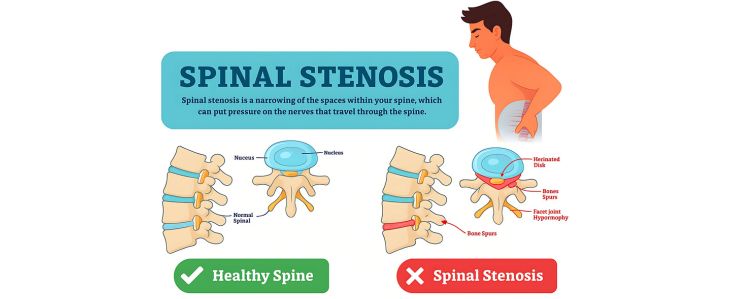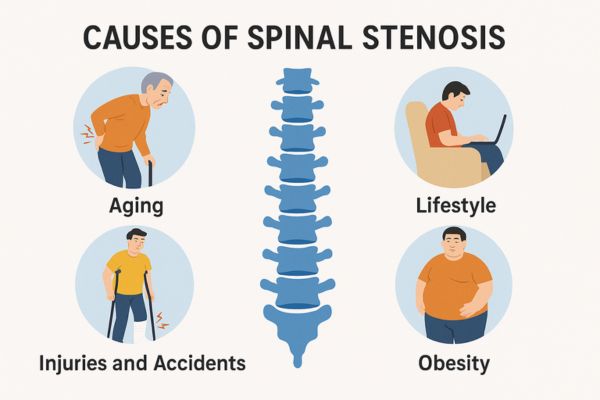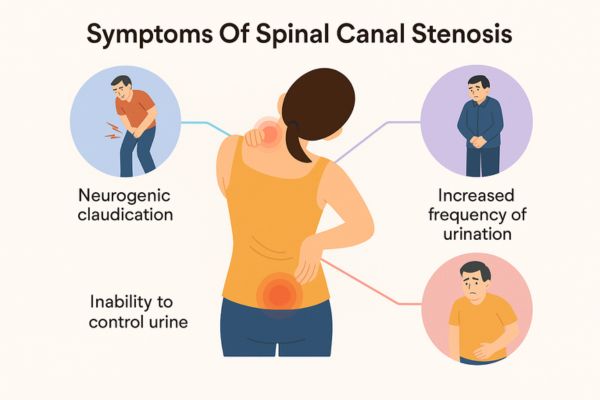Spinal Stenosis Treatment in Mumbai by Dr. Vishal Kundnani

What is spinal stenosis ?
Spinal stenosis treatment in Mumbai by Dr. Vishal Kundnani offers specialized care for patients experiencing the effects of this degenerative spinal condition. Spinal stenosis is a condition where the space available for neural elements within the spinal column becomes narrowed. This narrowing reduces the space within the spinal canal, leading to compression of the spinal cord and the nerve roots. Over time, this compression can cause a variety of symptoms, including chronic back pain, numbness, tingling, weakness in the limbs, and difficulty walking or maintaining balance.
The condition may result from age-related changes such as osteoarthritis, disc degeneration, or thickening of spinal ligaments. In more severe cases, it can significantly impair mobility and overall quality of life.
Dr. Vishal Kundnani, a renowned spine specialist in Mumbai, utilizes advanced diagnostic tools and personalized treatment strategies to address spinal stenosis effectively. Depending on the severity, treatment may include non-surgical options like physical therapy, pain management, and epidural injections, or surgical interventions such as decompression surgery or spinal fusion to relieve pressure on the spinal cord and nerves.
What is the causes of spinal stenosis ?

 Primary
/ Developmental spinal stenosis- which means you've had it since birth although the symptoms
appear in later part of the life. This is a form of inherited stenosis called short pedicle
syndrome. These patients are more prone to develop symptoms in midlife. Primary spinal
stenosis isn't common.
Primary
/ Developmental spinal stenosis- which means you've had it since birth although the symptoms
appear in later part of the life. This is a form of inherited stenosis called short pedicle
syndrome. These patients are more prone to develop symptoms in midlife. Primary spinal
stenosis isn't common. The
second category is the commonest and happens due to wear and tear or degeneration process.
This results from degenerative changes in the ligaments of the canal or due to some disease
or injury to the spine. The most common direct cause of spinal stenosis is osteoarthritis of
spine coupled with degenerative changes in the disc and facet joints.
The
second category is the commonest and happens due to wear and tear or degeneration process.
This results from degenerative changes in the ligaments of the canal or due to some disease
or injury to the spine. The most common direct cause of spinal stenosis is osteoarthritis of
spine coupled with degenerative changes in the disc and facet joints. Aging
: as a part of the normal age related degenerative process.
Aging
: as a part of the normal age related degenerative process. Life
style : Stress and emotional tension, poor posture -standing for long periods of time or
sitting incorrectly—can cause spinal stenosis , heavy physical work, lifting or forceful
movement, bending, or awkward positions can really hurt your back.
Life
style : Stress and emotional tension, poor posture -standing for long periods of time or
sitting incorrectly—can cause spinal stenosis , heavy physical work, lifting or forceful
movement, bending, or awkward positions can really hurt your back. Injuries
and Accidents : Injury to muscle , ligaments , or soft tissue can lead to spinal stenosis
.Fracture in spinal bone in a fall or a car accident also is a common cause
Injuries
and Accidents : Injury to muscle , ligaments , or soft tissue can lead to spinal stenosis
.Fracture in spinal bone in a fall or a car accident also is a common cause Obesity
: Being overweight puts pressure and stress on the back, especially the low back. Carrying
excess weight aggravates other health conditions such as osteoporosis (weak bones),
osteoarthritis (joint pain), rheumatoid arthritis (an autoimmune disease), degenerative disc
disease (described above in the aging section), spinal stenosis, and spondylolisthesis.
Obesity
: Being overweight puts pressure and stress on the back, especially the low back. Carrying
excess weight aggravates other health conditions such as osteoporosis (weak bones),
osteoarthritis (joint pain), rheumatoid arthritis (an autoimmune disease), degenerative disc
disease (described above in the aging section), spinal stenosis, and spondylolisthesis.
Specific conditions can present with secondary stenosis
 Large
Slip disc
Large
Slip disc Facetal
arthritis
Facetal
arthritis Spondylosis
Spondylosis
 Primary
spinal tumours
Primary
spinal tumours Spinal
Metastatic tumours
Spinal
Metastatic tumours Infections
Infections
 Tuberculosis
Tuberculosis
 Spinal
Fracture
Spinal
Fracture
What are the symptoms are spinal canal stenosis ?
This depends on the level at which the stenosis is in the spine. Lower spine (lumbar) stenosis can present as –

 Neurogenic
claudication – Pain or cramping in legs during standing stand for long periods of time or
when you walk. The discomfort usually eases if you bend forward or sit down, but comes back
when you stand upright. Symptoms which appear on walking and subside when you bend forward
is typical of lumbar spinal stenosis. This type of pain is called neurogenic claudication.
Patients with this condition may find walking uphill or climbing stairs more comfortable
than
walking straight.
Neurogenic
claudication – Pain or cramping in legs during standing stand for long periods of time or
when you walk. The discomfort usually eases if you bend forward or sit down, but comes back
when you stand upright. Symptoms which appear on walking and subside when you bend forward
is typical of lumbar spinal stenosis. This type of pain is called neurogenic claudication.
Patients with this condition may find walking uphill or climbing stairs more comfortable
than
walking straight. Increased
frequency of urination or
Increased
frequency of urination or Urgency
of urination
Urgency
of urination Inability
to control urine.
Inability
to control urine.
Depending on the location the spinal stenosis has been classified into cervical spinal stenosis or lumbar canal stenosis
Cervical Spinal Stenosis:
 Spinal
stenosis in neck (cervical spine) can cause.
Spinal
stenosis in neck (cervical spine) can cause. Neck
pain.
Neck
pain. Shoulders
pain.
Shoulders
pain. Vertigo,
giddiness.
Vertigo,
giddiness. Arm
pain.
Arm
pain. Pain
in nape of neck.
Pain
in nape of neck. Forearm
pain.
Forearm
pain. Difficulty
in walking.
Difficulty
in walking. Imbalance
during walking.
Imbalance
during walking. Numbness
in hands.
Numbness
in hands. Difficulty
in finer functions of hand such as holding a glass, change of signature etc.
Difficulty
in finer functions of hand such as holding a glass, change of signature etc. Headaches.
Headaches.
 Numbness,
or muscle weakness.
Numbness,
or muscle weakness. Loss
of balance, which can lead to clumsiness or a tendency to fall.
Loss
of balance, which can lead to clumsiness or a tendency to fall.

